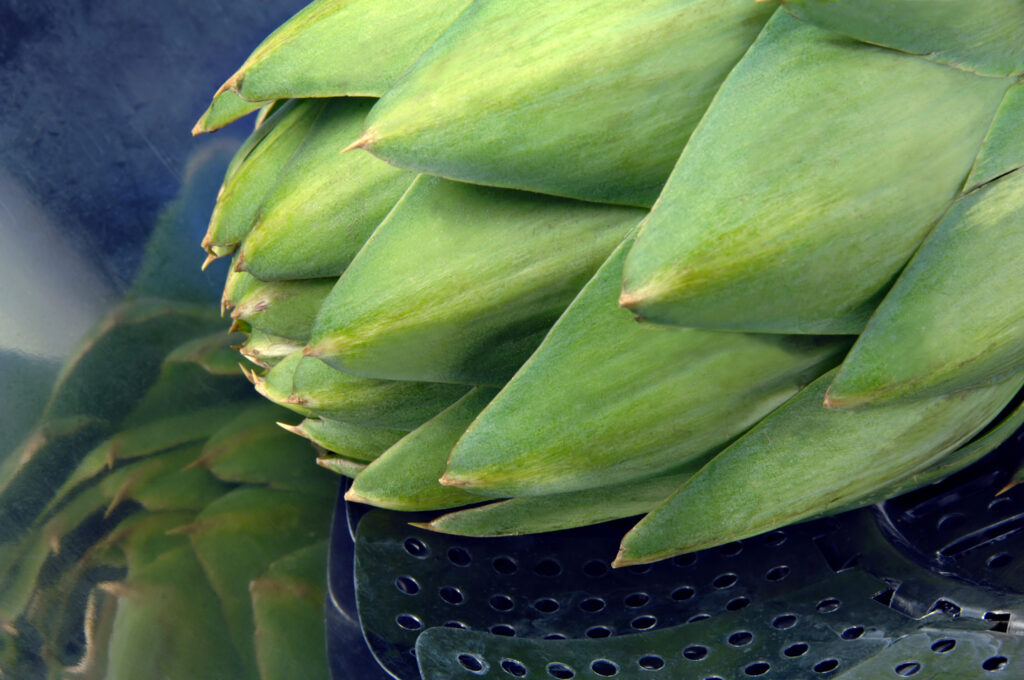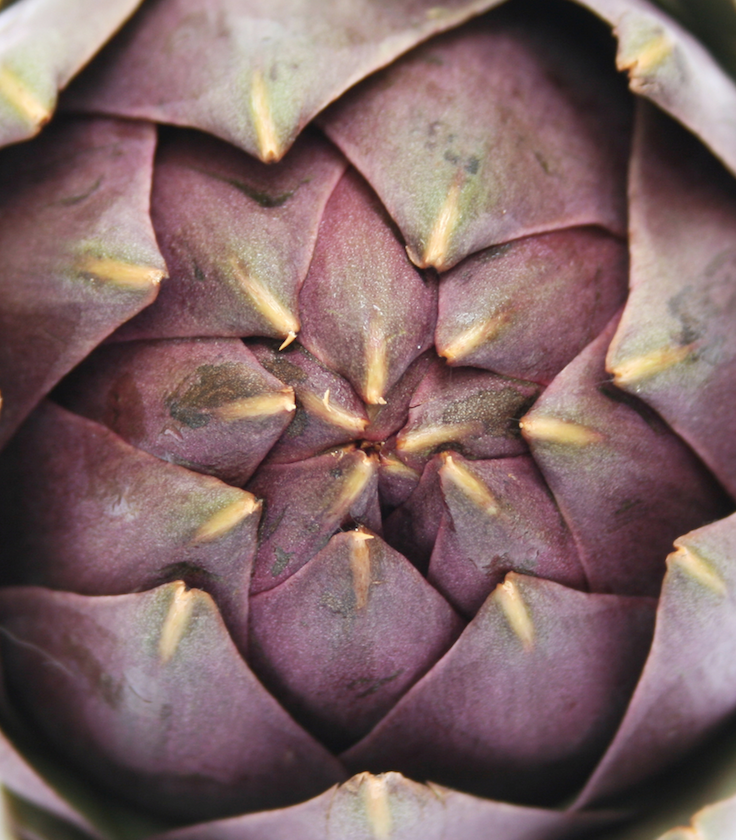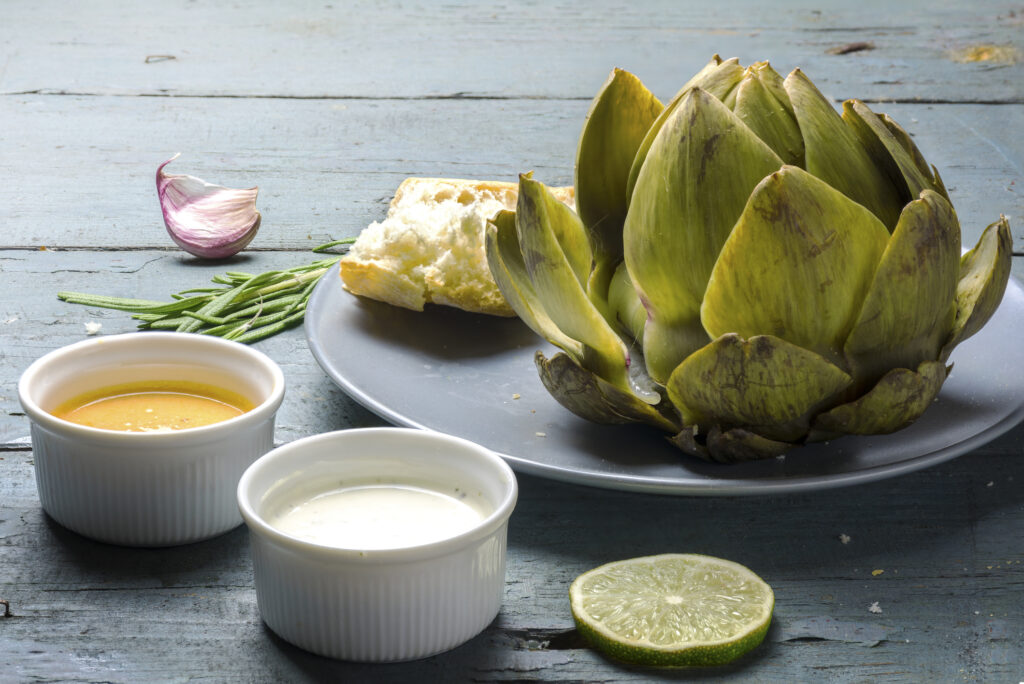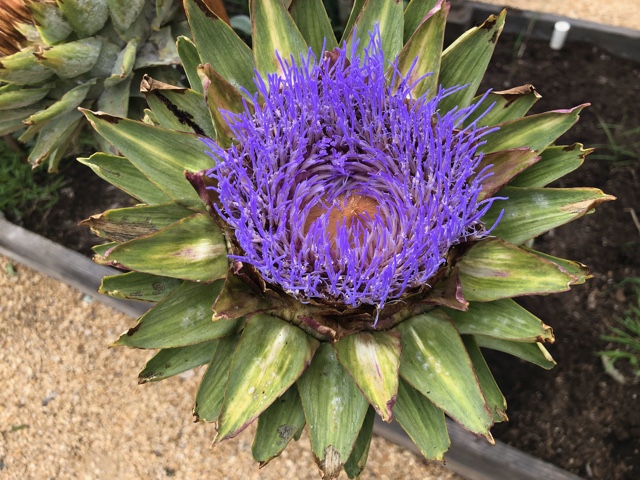
Artichokes are the edible flower buds of a thistle plant called Cynara scolymus. The botanical name derives from a Greek myth about Zeus, who fell in love with a beautiful woman named Cynara.
The story goes that Zeus was visiting his brother Poseidon one day on a small Aegean island, when he came upon the stunning Cynara (“Kynara” in Greek). As he often did when meeting a pretty maiden, Zeus fell head over heels for her. He offered to transform her into a goddess so she could live near him on Mt. Olympus, and they could tryst whenever his wife Hera was away.
Initially, Cynara consented. But she soon grew tired of Olympian life. She missed her home and her mother. So, one night, she slipped away for a short visit. Zeus discovered Cynara’s “betrayal,” and flew into a rage. He transformed her into an artichoke and cast her back to earth, where her heart would be covered in thorns, never to be loved by another.
Ol’ Zeus clearly got it wrong. Despite their prickly nature, artichokes have been loved by millions and millions for generations. There are good reasons for that: not only are they delicious, they’re also very healthy.
An Ancient Crop
Artichokes have been cultivated in Ethiopia and Egypt since approximately 5,000 BC. They were brought to the Mediterranean where they proliferated and became a staple in Italy, France, and Spain. Our English word “artichoke” comes from the old Spanish “alcarchofa,” which itself comes from the Andalusi Arabic “al-kharshufa.” The root is the Arabic word “harashef” which means “scale” in the sense of a fish or lizard’s scales—an apt description of this vegetable’s rather reptilian appearance.
In the 1800’s, French settlers brought artichokes to Louisiana, and Spanish merchants transported them to California where they took root. By the 1920s, artichokes were being cultivated in California’s Monterey Bay area, where the cool, foggy climate proved to be ideal. Now, almost all artichokes consumed in the US are grown in Castroville California, the self-proclaimed “artichoke capital of the world.”
Though the US grows over 42,000 tons of artichokes each year, Italy and Spain are still the big thistles in the global market, producing 387,803 tons and 223,150 tons respectively. Egypt is third, at 185,695 tons, according to the United Nations Food and Agriculture Organization.
Artichokes are popular in California, and among Mediterranean and Middle Eastern immigrants and their descendants nationwide. But they have not (yet) become a staple of the mainstream American diet.
When visiting the mid-west a few years ago, I brought a beautiful platter of steamed artichokes and dip to an event. Almost no one touched it. As the evening progressed, I learned why: the guests weren’t eating it because they didn’t know how!
Once I jumped in and demonstrated the technique, the leaves rapidly disappeared and the competition to eat the hearts ensued.
To eat an artichoke, simply remove one leaf at a time and dip its cupped surface into your favorite sauce. Then draw it across your lower teeth, scraping off the nutty flesh at the base of each leaf.
Anatomy of an Artichoke
If you’re an artichoke novice, this vegetable might seem like a lot of work to eat. But don’t rush it, or you’ll miss the wonderful sacred geometry.

The thorny artichoke leaves are arranged in a rotating spiral, a perfect expression of the Fibonacci sequence which is also visible in sunflowers and romanesco (cauliflower). This beautiful pattern makes artichokes particularly fun to eat, as each leaf is peeled away and nibbled, to ultimately reveal the choke: a set of small, thorny leaves covering a mound of sticky fibers, like corn silk, sprouting from the tender heart.
Once the inedible choke has been removed, the delicious heart is revealed. It is completely edible, and usually gobbled quickly.
Culinary Preparations
The first key to making yummy artichokes is to choose them carefully. Select globes that are firm, round, and seem heavy for their size. Avoid ones with dry leaves that are already opening like a flower, as they are past their prime.
To prepare, stabilize the artichoke on a cutting board and using a sharp knife, cut off all but ½ inch of the stem at the base, which can be considered an extension of the heart. Using kitchen scissors, snip off the thorny tips of outer leaves and remove the short, stubbly leaves at the base. Spread the leaves open slightly and sprinkle with minced garlic, tarragon, and black peppercorns.
Steam covered, stem side up, for 30-40 minutes, being careful to have enough water so the pan doesn’t run dry and burn. Allow it to cool for a few minutes. If it is being served whole, then spread the leaves open and remove all of the short, thorny leaves and fibers of the choke from the heart. Or, cut it in half lengthwise and remove the inner thorny petals. Remove ALL of the cottony choke with a melon baller or teaspoon.

Another approach is to boil the artichokes (trimmed as above) in 2 or 3 quarts of water, seasoned with olive oil, salt, black pepper, juice from a fresh lemon, coarsely chopped garlic, and fresh or dried herbs such as oregano, thyme, rosemary, bay leaves and tarragon. It usually takes about an hour to cook thoroughly, though one can reduce the cooking time by splitting the artichokes in half. Once the ‘chokes are cooked, the residual liquid–strained of all the loose garlic and herbs–makes a tasty base for soup or for boiling rice or pasta.
Serve artichokes with your favorite dip: extra-virgin olive oil with balsamic vinegar, melted butter or mayonnaise, perhaps mixed with coarse grain mustard or chimichurri sauce.
There are many other ways to prepare artichokes, as good Middle Eastern cookbooks will attest. They can be fried, grilled, stuffed and baked, or stewed with other vegetables. The tender hearts, shorn of all fibrous leaves can be preserved in oil and then eaten as an appetizer, side dish, or salad topping. Or they can be mashed or pureed and used in dips or spreads.
There’s even a company called Cynara that’s marketing artichoke “Chyps.”
Myriad Health Benefits
The somewhat arduous process of preparing and eating artichokes is worth the effort because they yield rich nutritional rewards.
Artichokes have one of the highest antioxidant profiles of all vegetables. They contain polyphenols such as cynarine, silymarin, and the flavonoids, rutin, quercetin, apigenin and luteolin, all of which have medicinal properties (Negro D, et al. J Food Sci. 2012).
One medium artichoke provides about 60-75 calories, along with almost 7 grams of fiber. They’re particularly rich in the prebiotic fiber, inulin, which supports microbiome production of short chain fatty acids, and helps balance blood sugar levels. In addition, artichokes are a good source of folate, and contain magnesium, iron, zinc, copper, and manganese, as well as vitamins C and K.

Historically, artichokes have been used to support digestive, liver, and cardiovascular health (Salem, MB, et al. Plant Foods Hum Nutrition, 2015).
There’s also evidence that artichoke leaf extract (ALE) improves symptoms of irritable bowel syndrome, and quality of life in people with dyspepsia. In one study, 208 adults with IBS were compared before and after a 2-month intervention with ALE. The investigators found a significant decline (24%) in IBS incidence after treatment. Quality-of-life score improved by 20%, supporting previous findings that ALE ameliorates symptoms of IBS (Bundy R, et al. J Altern Comp Ther. 2004).
Artichoke leaf extract also has hepatoprotective effects, reducing elevated liver enzymes, stimulating the production of glutathione, and improving bile flow from the liver due to its choleretic action.
In a double-blind pilot trial, 100 subjects with non-alcoholic fatty liver disease (NAFLD) were randomized to either 600 mg ALE daily or placebo, for 2 months. Those treated with ALE showed increased hepatic vein diameter and increased blood flow, along with a reduction in liver size, and lowered serum ALT and AST. In addition, ALE reduced total cholesterol, as well as LDL, HDL, and triglycerides (Panahi, Y, et al. Phytotherapy Res. 2018).
In another interesting study, rats treated with ALE prior to paracetamol poisoning showed a significant increase in glutathione level (GSH), glutathione reductase (GR) and glutathione-S-transferase (GST) activities. They also had lowered ALT and AST, and increased superoxide dismutase. All of this suggests that ALE may protect the liver from paracetamol-induced injury (Elmorsy EM, Kamel R. Pharmaceutical Biol. 2015).
Another study indicates that ALE may protect against lead toxicity, and lower serum lead levels in rats fed a lead-containing diet (Heidarian E, Rafeian-Kopaei M. Pharmaceutical Biol. 2013).
Heart-Friendly
In a nod to the Doctrine of Signatures, artichokes—which look somewhat like human hearts–are quite heart-healthy.
To assess the effects of ALE on lipid profiles, researchers at the University of Pavia, Italy, randomized 92 overweight subjects with hypercholesterolemia to 250 mg ALE or placebo for 8 weeks. After the 2-month period, the ALE group showed a rise in HDL cholesterol, with a corresponding reduction in total cholesterol, LDL, the TC/HDL ratio, and the LDL/HDL ratio (Rondanelli M, et al. Int J Food Sci Nutr. 2012).
“These results indicate that ALE could play a relevant role in the management of mild hypercholesterolemia, favoring in particular the increase in HDL-C, besides decreasing total cholesterol and LDL-cholesterol,” reported Mariangela Rondanelli, the lead author.
As a food and as a medicine, the artichoke has a venerable past and a bright future. If you’re not already familiar with this wonderful vegetable, I urge you to give it a try.
END
Sally LaMont, ND, LAc, is a naturopathic doctor and acupuncturist with over 30 years of experience in functional medicine. She practices at the Marin Natural Medicine Clinic in Larkspur, CA, and specializes in a range of digestive problems, thyroid, adrenal and female hormonal imbalances, brain fog and early dementia, and other chronic diseases.
Dr. LaMont earned her ND in 1981 from the National University of Naturopathic Medicine and her Master of Science in Oriental Medicine in 1986 at Emperor’s College of Traditional Chinese Medicine. She completed advanced training in The Bredesen Protocol to Prevent and Reverse Cognitive Decline through the Institute for Functional Medicine and the Buck Institute of Aging. Her love of cooking and firm belief in food as medicine inspired her newest project, Dr. Sally’s Kitchen, an educational website offering “Rx Recipes” and “Food Pharmacy” guidance for patients and practitioners.







